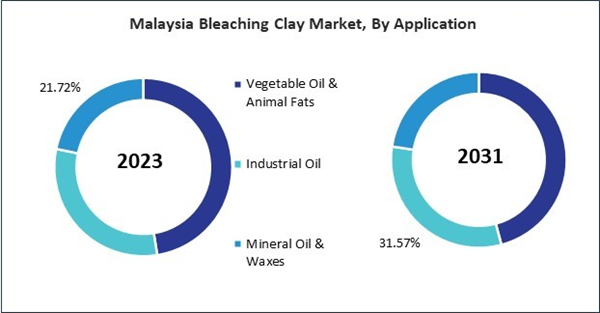Activated bleaching clay is a specialized form of bleaching clay that undergoes an activation process to enhance its adsorption properties, making it highly effective in removing impurities, color, and contaminants from oils and other substances. Therefore, the China market would utilize 213.92 kilo tonnes of Activated bleaching clay by 2031.
The China market dominated the Asia Pacific Bleaching Clay Market by Country in 2023, and would continue to be a dominant market till 2031; thereby, achieving a market value of $165.1 Million by 2031. The Japan market is experiencing a CAGR of 6.1% during (2024 - 2031). Additionally, The India market would exhibit a CAGR of 7.5% during (2024 - 2031).
Bleaching clay, activated clay, or bleaching earth, is a highly versatile and widely used adsorbent material with diverse applications across various industries. Derived primarily from natural minerals such as bentonite and attapulgite, it is valued for their exceptional adsorption properties, which make them ideal for purifying and refining a wide range of substances, including edible oils, petrochemicals, and industrial chemicals.
Additionally, the adoption of bleaching clays spans numerous industries, driven by their effectiveness in removing impurities, colorants, and contaminants from raw materials and finished products. In the petrochemical industry, it purifies crude oils, lubricants, and fuels by removing impurities, sulfur compounds, and colorants. This purification process enhances petrochemical products' quality, stability, and performance, ensuring compliance with industry standards and regulatory requirements.
Furthermore, India is one of the largest producers of generic pharmaceuticals, with a vast network of manufacturing facilities producing active pharmaceutical ingredients (APIs) and formulations. It is used to purify pharmaceutical ingredients, such as glycerin and oils, to remove impurities, colorants, and contaminants. As per the data released in 2023 by the India Brand Equity Foundation, it is expected that the Indian pharmaceuticals sector will attain a value of US$65 billion by 2024 and US$130 billion by 2030. The Indian pharmaceutical industry is estimated to be worth around $50 billion, of which more than $25 billion is derived from exports. Therefore, the expansion of the pharmaceutical and food & beverage sectors in the Asia Pacific can lead to enhanced demand for bleaching clay in the region.
Based on Product Type, the market is segmented into Activated Bleaching Clay, and Natural Bleaching Clay. Based on Application, the market is segmented into Vegetable Oil & Animal Fats, Industrial Oil, and Mineral Oil & Waxes. Based on countries, the market is segmented into China, Japan, India, South Korea, Singapore, Malaysia, and Rest of Asia Pacific.
List of Key Companies Profiled
- Arkema S.A.
- Clariant AG
- DuPont de Nemours, Inc.
- BASF SE
- Kemira Oyj
- Merck KGaA
- Akzo Nobel N.V.
- EP Minerals, LLC (U.S. Silica Holdings, Inc.)
- Oil-Dri Corporation of America
- Musim Mas Group
Market Report Segmentation
By Product Type (Volume, Kilo Tonnes, USD Billion, 2020-2031)- Activated Bleaching Clay
- Natural Bleaching Clay
- Vegetable Oil & Animal Fats
- Industrial Oil
- Mineral Oil & Waxes
- China
- Japan
- India
- South Korea
- Australia
- Malaysia
- Rest of Asia Pacific
Table of Contents
Companies Mentioned
- Arkema S.A.
- Clariant AG
- DuPont de Nemours, Inc.
- BASF SE
- Kemira Oyj
- Merck KGaA
- Akzo Nobel N.V.
- EP Minerals, LLC (U.S. Silica Holdings, Inc.)
- Oil-Dri Corporation of America
- Musim Mas Group
Methodology

LOADING...









